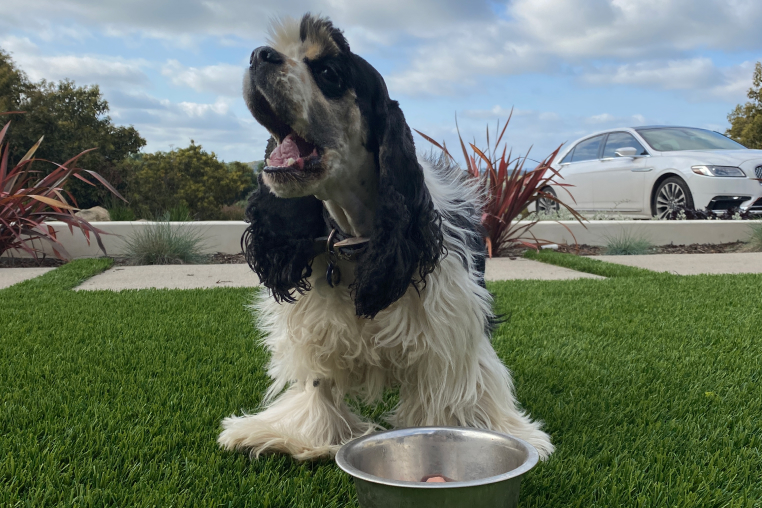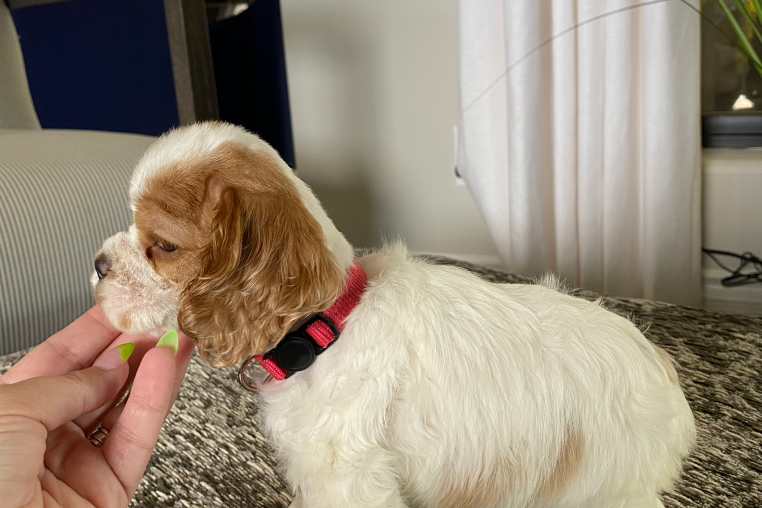Has your Cocker Spaniel been diagnosed with hip dysplasia? You are not alone.
This is a common concern with most dog owners. It can happen to dogs of any size or age. But the funny aspect of hip dysplasia is that many affected dogs, especially young dogs, do not show clinical symptoms of this condition until they grow older. You need to have a deep insight into this disease to be able to save your dog on time.
If you are a Cocker Spaniel owner, this guide will reveal all you need to know about Cocker Spaniel hip dysplasia treatment. And because prevention is better than cure, we are also going to look at how you can prevent your Cocker Spaniel from hip dysplasia.
What Is Hip Dysplasia?
Puppy hip dysplasia is something very common in dogs. It is a dog disease that affects a dog’s hip joint causing it not to fit well. Because the bones don’t seat well, they unsteadily rub together. With time, this can cause cartilage loss, resulting in lameness, degenerative long-term joint disease, and chronic pain. Hip dysplasia affects most pets, and every dog affected by this disease will develop osteoarthritis (to some degree). As much as the disease is genetic, there are eventually other factors like genes, that can cause hip dysplasia. Again, not every dog with these genes can develop hip dysplasia.
Though smaller breeds do suffer from hip dysplasia, bigger dogs have shown to be more prone to the condition. Below is a list of dogs that are open to this disease.
- Great Danes
- Boxers
- Labs
- Pitbulls
- German Shepherds
- Schipperkes
- Australian Shepherds
- Labrador Retriever
- Golden Retriever
Besides the above list, lager-breed dogs are also prone to hip dysplasia due to their weight. So, it is important to do routine checkups (8 wks. To 10 months), if your dog is a large-breed dog.
Hip Dysplasia Causes

One main cause of hip dysplasia is genetics (as discussed earlier.) A puppy is likely to suffer from hip dysplasia if the parents have had it in the past. Additionally, insufficient exercise and improper diet are also prospective causes of hip dysplasia in dogs. Excess weight on dogs put pressure on the joints of a dog, and lack of exercise allows for more weight gain and risk of hip dysplasia development.
Hip Dysplasia Symptoms
As much as hip dysplasia is, (in some cases), stubborn to be detected, there are still some visible signs such as:
- Occasional or chronic lameness
- Limping without injury or trauma
- Popping and cracking joint sounds
- Bunny hopping
- Stiffness
- Tigh muscle lose
- Unusual gait
- Strange sitting positions
- Standing difficulty
- Climbing difficulty
- Jumping difficulty
- Difficulty playing around
- Unwilling to take a usual walk
- etc.
Even if your Cocker doesn’t show clinical symptoms, you will still notice your Cocker Spaniel showing signs of pain because the condition is painful.
Diagnosing Hip Dysplasia
The best hip dysplasia diagnosis is hip radiography or hip x-ray. If you are suspecting your Cocker Spaniel of having hip dysplasia, you should immediately take him to a veterinarian for hip radiography. Your vet can equally use his/her hands on the hip of your dog to observe possible hip dislocation.
Cocker Spaniel Hip Dysplasia Treatment
You already know that hip dysplasia can be inherited or caused by natural factors. If your dog’s case is inherited, it cannot be treated. You can only manage it. But if it is caused by natural factors, then it can be fully treated.
Either way, here are effective treatment and management options to save your Cocker Spaniel from hip dysplasia. One of them include simple dog hip dysplasia home treatment.
1. Physical treatment –
These treatments include – massage and using underwater treadmills. These treatments will help to mitigate the pain your dog is suffering from. These can be performed by you or your vet but make sure you understand the limitations of your dog, if not, talk to your veterinarian.
2. Exercise –

Though your dog may be in pain, you can still get him to do some low-impact exercises like leash walking or swimming. This will help increase your dog’s muscle strength and tendon, and also reduce joint pain. Be advised that, when taking your dog on a walk, make sure you protect him from hard surfaces to avoid any further harm.
3. Prescription formulas for dog joints –
These formulas are good for boosting the healing process of cartilage and also reducing inflammation. Whatever formula you go for, make sure it’s recommended by a veterinarian.
4. Pain medication –
The best pain medications are (NSAIDs). These medications help in pain reduction and must be veterinarian recommended.
5. Arrange a friendly space –
You can use a slopping surface linking two different levels. This way, your dog can start practicing the act of getting into the car, in bed, and also moving around. You can also use a soft mattress. Choosing the best quality dog bed can make a great difference for dogs with hip dysplasia. Some people use heated dog beds in a colder climate but watch out for overheating in order not to burn your pooch.
6. Surgery –
Surgical procedures such as – Hip replacement and Juvenile public symphosiodesis are the most widely practiced treatment method for this condition by pet owners. But if any of these is what your dog needs, then your veterinarian needs to guide you through. And if he is a board-certified veterinarian, then he might as well take care of the procedure. But if not, he can refer you to one. (The right one). Dog hip dysplasia surgery cost can be high, but if your dog is insured, the insurer can waive all the expenses for you.
7. Weight control –
Any dog experiencing joint pain must be kept at a healthy weight, irrespective of surgical or medication treatment. By maintaining a healthy weight, you can prevent your dog from carrying extra weight on the joints. Consult your regular veterinarian for advice on a weight-management strategy. Joint pain that occurs as a result of excess weight can be avoided by maintaining a healthy weight.
8. Orthopedic Braces –

If surgery is not an option for your dog, there are several conservative, non-invasive care choices. The Ortho Dog’s Hip Brace offers stability and support to lessen stress on canine joints and enable post-surgical recovery. There is a size for every pet, you can get one that fits well and offers the most support.
The quicker your dog is treated, the better the results. To halt the disease’s progression, bracing along with exercise is advised as soon as possible. But the end-stage hip dysplasia in dogs is often easy to deal with.
How to Prevent Hip Dysplasia?
Hip dysplasia is something you may not be able to completely avoid. However, several actions can lower the likelihood that your dog will contract this illness. Maintaining a healthy weight for your pet, especially while he’s young, can help slow the growth of hip dysplasia’s negative effects. When your Cocker Spaniel is young is the best time to maintain the health of his skeletal system. Giving your puppy the right nutrition will give him healthy joint and bone development and also help in preventing the disease-causing excessive growth.
As your dog gets older, giving him the right exercise and feeding him a nutritious diet will help keep him from becoming obese, which is a big risk factor for hip dysplasia. Cut down on scrappy fatty foods because obesity also contributes to a host of other health issues in dogs. Do your homework about the breed of dog you want to get before you buy one. Find a trustworthy breeder who does the necessary health examinations, like hip dysplasia radiography and other conditions. Breeders should check their breeding dogs for hereditary hip dysplasia to prevent it as much as possible.
How Long Can a Dog Live with Hip Dysplasia?
A dog suffering from hip dysplasia can live as long as possible with the correct surgical and medicinal treatment. Your dog should have regular physical checkups from your veterinarian, perhaps once every six months, to guarantee joint health and to promote muscle strength and mobility.
Cost of Treating Hip Dysplasia

Hip dysplasia treatment costs can reach hundreds of dollars. But the moment you acquire your dog before any symptoms of an illness appear, consider getting him insured. This implies that if he becomes sick or acquires a problem like hip dysplasia, you will receive all the assistance you need to take care of him.
Frequently Asked Questions
1. How Long Can Dogs Live with Hip Dysplasia?
There may not be a definite answer to this question but a well-managed or treated case can enable your dog to live a long and happy life. You just have to keep a close eye on your dog from the time you purchased him and take good care of him.
2. Can Dog Hip Dysplasia Heal on Its Own?
From experience, we have never come across an affected dog who got healed on its own, without treatment. The consequences of hip dysplasia in dogs are near impossible for any dog to survive without treatment. Because first, it is very painful, and complications will keep degenerating from one level to another due to movement. The condition needs to be managed so the dog can get back to good health.
3. What is the Best Thing to Do for a Dog with Hip Dysplasia?
No one thing is the best thing to do for a dog with hip dysplasia. When you notice that your dog has hip dysplasia, the first thing to do is to take the dog to an expert for hip radiography. This will tell the expert the intensity of the problem and what exactly is needed before treatment can commence. Surgical procedures are the best treatment for this condition but there are alternatives to surgery for hip dysplasia in dogs which include – Nutraceuticals, Vitamin C and E, Fatty Acids, Herbs, Alfalfa, Colostrum, and Acupressure.
4. What are the First Signs of Hip Dysplasia in Dogs?
The first thing you will notice in a dog with hip dysplasia is that your dog begins to withdraw from his usual activities. You will see that the dog is gradually withdrawing from his common loveable activities around the house. Thereafter, other symptoms will follow such as Occasional or chronic lameness, limping without injury or trauma, Popping and cracking joint sounds, Bunny hopping, Stiffness, Thigh muscle loss, unusual gait, Strange sitting positions, standing difficulty, Climbing difficulty, Jumping difficulty, Difficulty playing around, Unwilling to take a usual walk, etc.
5. How a Dog Walks with Hip Dysplasia?
It is impossible to see a dog with hip dysplasia walking correctly because hip dysplasia attacks the hip joint of the dog. With a dislocated joint, I don’t see how any living creature can walk well.
Conclusion
Early detection of hip dysplasia is essential for effective Cocker Spaniel hip dysplasia treatment. After a diagnosis, your veterinarian can work with you to develop a strategy for treatment that will lessen any pain your dog might be feeling and help them keep its mobility. Hip dysplasia dogs treatment varies on several factors, but your vet will ensure that your dog can live longer and happily again.

Leave A Comment